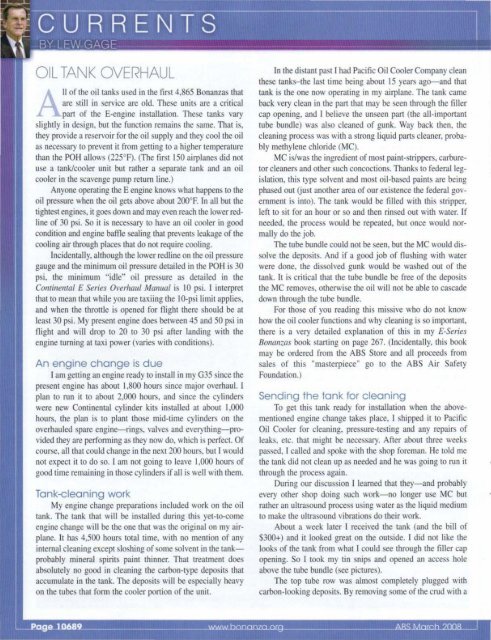Q - American Bonanza Society
Q - American Bonanza Society
Q - American Bonanza Society
You also want an ePaper? Increase the reach of your titles
YUMPU automatically turns print PDFs into web optimized ePapers that Google loves.
OIL TANK OVERHAULII of the oil tanks used in the first 4.865 <strong>Bonanza</strong>s thatare still in service are old. These units are a criticalpart of the E-engine installation. These tanks varyslightl y in design, but the function remains the same. That is,they provide a reservoir for the oil supply and they cool the oilas necessary to prevent it from getting to a higher temperaturethan the POH allows (225' F). (The fi rst 150 airplanes did notuse a tank/cooler unit but rather a separate tank and an oilcooler in the scavenge pump return line.)Anyone operating the E engine knows what happens to theoil pressure when the oil gets above about 200' F. In all but thetightest engines, it goes down and may even reach the lower redlineof 30 psi. So it is necessary to have an oil cooler in goodcondition and engine baffle sealing that prevents leakage of thecooling air through places that do not require cooling.Incidentall y, although the lower redline on the oil pressuregauge and the minimum oil pressure detailed in the POH is 30P i, the minimum "idle" oil pressure as deta iled in theContinental E Series Overhaul Manual is 10 psi. I interpretthat to mean that while you are taxiing the 10-psi limit applies,and when the throttle is opened for flight there should be atleast 30 psi. My present engine does between 45 and 50 psi infli ght and wi ll drop to 20 to 30 psi after landing wi th theengine turning at taxi power (varies with conditions).An engine change is dueI am getting an engine ready to install in my G35 since thepresent engine has about 1,800 hours since major overhaul. Iplan to run it to about 2.000 hours. and since the cylinderswere new Continental cylinder kits installed at about 1,000hours, the plan is to plant those mid-time cylinders on theoverhauled spare engine-rings, valves and everything-providedthey are perfonning as they now do, which is perfect. Ofcourse, all that could change in the next 200 hours, but I wo uldnot expect it to do so. I am not going to leave 1,000 hours ofgood time remaining in those cylinders if all is we ll with them.Tank-cleaning workMy engine change preparations included work on the oiltank. The tank that will be installed during this yet-to-comeengine change will be the one that was the original on my airplane.It has 4,500 hou rs total time, with no mention of anyintern al cleaning except sloshing of some solvent in the tankprobablymineral spirits paint thinner. That treatment doesabsolutely no good in cleaning the carbon-type deposits thataccumulate in the tank. The deposits will be especially heavyon the tubes that form the cooler ponion of the unit.In the distant past I had Pacific Oil Cooler Company cleanthese tanks-the last time being about 15 years ago-and thattank is the one now operating in my airplane. The tank cameback very clean in the part that may be seen through the fillercap opening, and I believe the unseen pan (the all-imponanttube bundle) was also cleaned of gunk. Way back then, thecleaning process was with a strong liquid parts cleaner, probablymethylene chloride (MC).MC is/was the ingredient of most paint-strippers, carburetorcleaners and other such concoctions. Thanks to federal legislation, this type solvent and most oil-based paints are beingphased out Gust another area of our existence the federal governmentis into). The tank would be filled with this stripper,left to sit for an hour or so and then rinsed out with water. Ifneeded, the process would be repeated, but once would normallydo the job.The tube bundle could not be seen, but the Me would dissolvethe deposits. And if a good job of flushing with waterwere done, the dissolved gunk would be washed out of thetank. It is critical that the tube bundle be free of the depositsthe MC removes, otherwise the oil will not be able to cascadedown through the tube bundle.For those of you reading this missive who do not knowhow the oil cooler functions and why cleaning is so important,there is a very detailed explanation of this in my E-Series<strong>Bonanza</strong>s book start ing on page 267. (Incidentall y, this bookmay be ordered from the ABS Store and all proceeds fromsales of this "masterpiece" go to the ABS Air SafetyFoundation.)Sending the tank for cleaningTo get this tank ready for installation when the abovementionedengine change takes place, I shipped it to PacificOil Cooler for cleaning, pressure-testing and any repairs ofleaks. etc. that might be necessary. After about three weekspassed, I called and spoke with the shop foreman. He told methe tank did not clean up as needed and he was going to run itthrough the process again.During our discussion I learned that they-and probablyevery other shop doing such work- no longer use MC butrather an ultrasound process using water as the liquid mediumto make the ultrasound vibrations do their work.About a week later I received the tank (and the bill of$300+) and it looked great on the outside. I did not like thelooks of the tank from what I could see through the filler capopening. So I took my tin snips and opened an access holeabove the tube bundle (see pictures).The top tube row was almost completely plugged wi thcarbon-looking deposits. By removing some of the crud with a
















